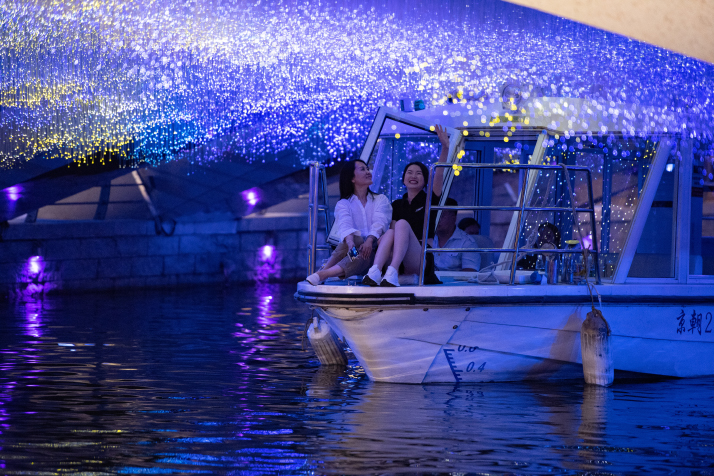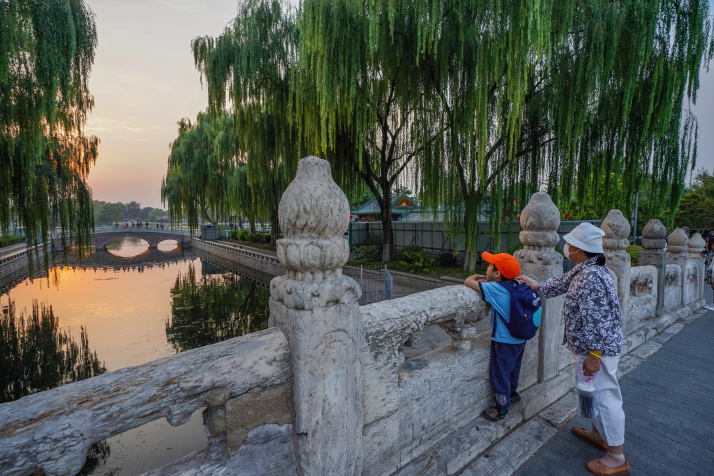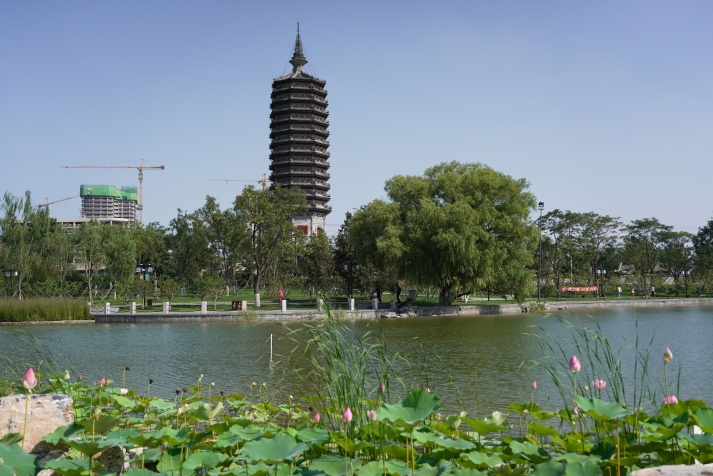| China |
| How the Beijing-Hangzhou Grand Canal regains its charm | |
|
|
 Tourists go boating on Beijing's Liangma River on July 13(XINHUA)
If you look at the map of China, you will see that almost all major rivers in the country flow from west to east. There is only one long river that flows from south to north. And this is not a natural stream, but an artificial one that stretches along nearly 1,800 km. It's the Beijing-Hangzhou Grand Canal. Located at the northernmost point of the Grand Canal, Beijing has been the capital of China for most time since the 1270s. In October, when the cooler temperatures of fall descend on the Chinese capital, Beijing's Tongzhou Grand Canal Forest Park offers some breathtaking golden-hued views. Tongzhou, a district in modern Beijing's eastern part, has been the doorway connecting the city with northeastern, eastern and southern regions of the country for almost 2,000 years. This area was once a busy wharf along the Grand Canal, making it a vibrant and prosperous trade hub. A towering lighthouse stands next to the waterfront, always attracting a steady stream of visitors. Once upon a time… "There's a saying: The shadow of the Randeng Pagoda recognizes Tongzhou," Li Ying, a tour guide at the Grand Canal Forest Park, told Beijing Review. "When ships sailing along the Grand Canal spotted the pagoda, they knew they had arrived in Tongzhou, they knew they had arrived in the capital." Enjoying worldwide fame and recognition, the Beijing-Hangzhou Grand Canal is the earliest, longest and largest canal in the world, often referred to as one of the two great ancient engineering wonders of China, along with the Great Wall, an ancient military defense project that stretches more than 6,000 km from west to east in north China and mainly covers 15 present-day provincial-level regions. The Grand Canal compromises several sections, with the earliest ones dating back to the fifth century B.C. Following two large-scale expansions in the seventh and 13th centuries, it became a major south-north transport artery. UNESCO inscribed the Grand Canal on its World Heritage List in 2014. In 1292, the Tonghui Canal was dug from Tongzhou to Beijing's contemporary Jishuitan area in the northwestern part of the city, allowing boats from Hangzhou to directly enter the city center and forming the course of the Grand Canal as we know it today. Combining the functions of politics, economy and culture, Beijing then became the center of exchange between the country's northern and southern regions and thus the most important destination along the stream.  People take in the views of Beijing's Shichahai area from the Wanning Bridge, which marks the intersection of the Beijing-Hangzhou Grand Canal and the Beijing Central Axis, on September 28, 2022 (XINHUA)
From its source at Baifuquan in northwest Beijing's Changping District to the waterfront terminal in Tongzhou, the ancient canal's journey also represents an extraordinary history of water conservation. The Beijing section of the Grand Canal has a total length of 82 km. Scattered along its banks are numerous cultural relics and archaeological sites, which serve as important carriers of culture and require the utmost protection. Since the 1990s, Beijing has greatly emphasized the canal's cultural significance. Efforts have been made to preserve and restore the water surfaces, improve water quality, open up navigable channels, and renovate the cultural relics along the banks. Today, the canal's centuries-old cultural heritage is being revitalized, connecting the cultural treasures along its banks. "The canal nourishes Beijing, and Beijing protects the canal," Li said. Today, all the way from Beijing to Hangzhou in east China's Zhejiang Province, more than 300 million people live on the banks of the Grand Canal. A mega undertaking, it wasn't just a corridor of Chinese civilization, but also gave China its earliest transportation management system.  The Randeng Pagoda in the Grand Canal Forest Park in Beijing's Tongzhou District on July 21, 2020 (XINHUA)
The flow of things The Grand Canal's cultural belt has received a contemporary upgrade. Beijing's Liangma River has become part of said belt. In 2019, the city opened the Liangma River International Waterfront Park. In 1421, Zhu Di, the third emperor of the Ming Dynasty (1368-1644), moved the national capital from Nanjing, capital of today's Jiangsu Province, to Beijing. He decided to set up the Imperial Horse Farm around the stream, resulting in the river's name: Liangma literally means "drying horses." From horse-washing station, the stream today has transformed into a water sports and leisure destination in the heart of the city. On Chinese social media, hashtag "Liangma nightscape" was a hot topic this summer. "This is where old and new come together," Wu Sheng, marketing director of the Liangma River International Waterfront Project, told Beijing Review. Four years ago, Beijing began the renovation of the very much overlooked and very dirty river and its surroundings. "The Liangma River represents a way of life. This area is close to Beijing's embassy area, is a place of business, politics and culture in the capital, and is also a place of highly successful integration," Wu explained. "Beijingers like having a waterfront area that is easy to get to after work, that stays lively in the evening and where they can just relax and let the worries of the day flow away," he concluded. This is where humanity and water coexist, growing and flowing together. Copyedited by Elsbeth van Paridon Comments to taozihui@cicgamericas.com |
|
||||||||||||||||||||||||||||
|
